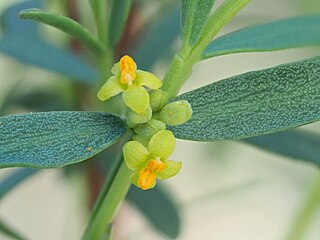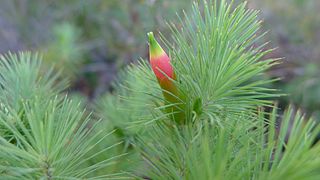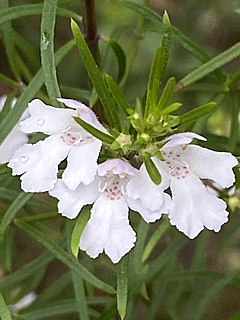
Pimelea spicata, commonly known as the spiked rice flower, is a flowering plant in the family Thymelaeaceae and is endemic to New South Wales. It is a slender plant with white flowers and elliptic leaves.

Dampiera stricta commonly known as blue dampiera, is a flowering plant in the family Goodeniaceae. It is a small sub-shrub with variable leaves and mostly blue, mauve or purple flowers.

Westringia dampieri, commonly known as shore westringia, is a flowering plant in the family Lamiaceae, it grows in South Australia and Western Australia. It is a small, dense shrub with white, mauve, cream or purple flowers.

Pimelea glauca, commonly known as smooth riceflower, is a species of small shrub in the family Thymelaeaceae and is endemic to Australia. It is not considered to be threatened.

Pimelea imbricata is a small shrub species in the family Thymelaeaceae. It is endemic to Western Australia.

Pimelea pauciflora, commonly known as poison rice-flower, is a species of shrub in the family Thymelaeaceae. It has small yellow-lime flowers, green, smooth fleshy leaves and is endemic to Eastern Australia.

Pimelea curviflora, also known as curved rice-flower is a shrub in the family Thymelaeaceae and is endemic to Australia. It is a small, hairy shrub with greenish-yellow or red tubular flowers.

Stenanthera pinifolia, commonly known as pine heath, is a species of shrub that is endemic to south-eastern Australia. It has narrow, linear leaves, yellow or red tubular flowers and a small edible berry.
Goodenia coronopifolia is a species of flowering plant in the family Goodeniaceae and is endemic to north-western Australia. It is a herb with mostly linear leaves, those at the base of the plant divided with narrow segments, racemes of yellow flowers with brownish-purple markings, and more or less spherical fruit.
Goodenia filiformis, commonly known as thread-leaved goodenia, is a species of flowering plant in the family Goodeniaceae and is endemic to near-coastal areas of south-western Western Australia. It is an erect to ascending herb with cylindrical to narrow linear leaves at the base of the plant and racemes of yellow flowers.

Goodenia pterigosperma is a species of flowering plant in the family Goodeniaceae and is endemic to south-coastal areas in the south-west of Western Australia. It is an erect to sprawling, glabrous perennial herb or shrub with linear to lance-shaped leaves mostly at the base of the plant, and racemes of dark blue flowers.
Goodenia quadrilocularis is a species of flowering plant in the family Goodeniaceae and is endemic to south-coastal areas in the south-west of Western Australia. It is an erect, woody perennial herb with egg-shaped to lance-shaped leaves with toothed edges, and racemes of yellow flowers.

Scaevola striata, commonly known as royal robe, is a species of flowering plant in the family Goodeniaceae. It has blue fan-shaped flowers, and is endemic to Western Australia.

Goodenia viscida, commonly referred to as viscid goodenia, is a species of flowering plant in the family Goodeniaceae and is endemic to the south-west of Western Australia. It is an erect perennial herb or shrub with narrow oblong to egg-shaped leaves with toothed edges, and spikes of yellow flowers.

Dampiera incana, commonly known as the hoary dampiera, is a flowering plant in the family Goodeniaceae and is endemic to Western Australia. It is a perennial herb with grey foliage and blue-purple flowers.

Westringia longifolia, commonly known as long-leaved westringia, is a flowering plant in the family Lamiaceae and is endemic to southeastern Australia. It is a small shrub, with linear leaves and mostly white flowers.

Westringia angustifolia, commonly known as scabrous westringia, is a flowering plant in the family Lamiaceae and is endemic to Tasmania. It is a small, upright shrub with mauve or white flowers.

Lechenaultia tubiflora, commonly known as heath leschenaultia, is a species of flowering plant in the family Goodeniaceae and is endemic to the south-west of Western Australia. It is a hemispherical subshrub or more or less erect perennial with crowded, narrow, rigid leaves and variably-coloured, tube-shaped flowers.

Leucopogon apiculatus is a species of flowering plant in the family Ericaceae and is endemic to the south of Western Australia. It is an erect shrub with oblong to elliptic leaves and pink to white tube-shaped flowers.

Leucopogon assimilis is a species of flowering plant in the family Ericaceae and is endemic to the south of Western Australia. It is an erect, slender shrub with linear or lance-shaped leaves and pink to white, tube-shaped flowers.

















